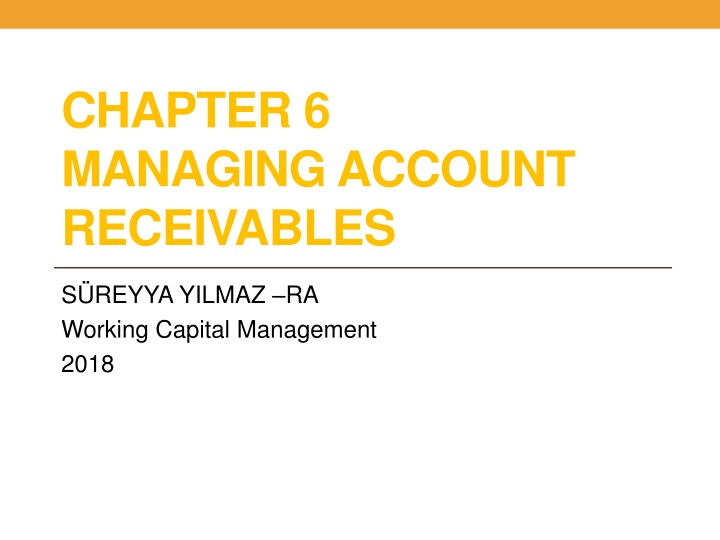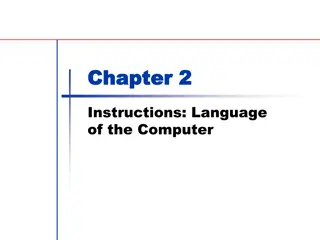Managing Account Receivables in Business Operations
Firms commonly offer credit terms to clients, creating trade credit and receivables. High trade receivables signify investment in clients, balancing sales growth with risks of bad debts and credit default. Efficient management of receivables is crucial for optimizing working capital and minimizing costs. This involves controlling credit policies, monitoring bad debts, and balancing the benefits of increased sales with associated risks. Proper receivables management ensures cash flow stability and enhances overall business profitability.
Download Presentation

Please find below an Image/Link to download the presentation.
The content on the website is provided AS IS for your information and personal use only. It may not be sold, licensed, or shared on other websites without obtaining consent from the author.If you encounter any issues during the download, it is possible that the publisher has removed the file from their server.
You are allowed to download the files provided on this website for personal or commercial use, subject to the condition that they are used lawfully. All files are the property of their respective owners.
The content on the website is provided AS IS for your information and personal use only. It may not be sold, licensed, or shared on other websites without obtaining consent from the author.
E N D
Presentation Transcript
CHAPTER 6 MANAGING ACCOUNT RECEIVABLES S REYYA YILMAZ RA Working Capital Management 2018
INTRODUCTION Firms usually sell their products on credit, rather than requiring immediate payment. generates a commercial credit (usually short term) for the seller and a commercial debt (usually short term) for the client. The general name given to commercial credit is trade credit . Likewise, the commercial credit provided is often referred to as trade receivables, whereas the commercial credit received is often referred to as trade payables . Such a transaction
INTRODUCTION Firms exhibiting high trade receivables are making a significant investment in clients. The expected return on this investment is linked to an increase in sales. However, this benefit comes at both an opportunity cost and a cost associated with the risk of recovering the invested capital. That is, in addition to the cost associated the time value of money, firms that finance their clients are subject to the risk of not being repaid on time or not being repaid in full. This latter risk, usually called credit risk, is a significant by-product of the decision to finance clients through trade receivables.
RECEIVABLES MANAGEMENT Receivables constitute a significant portion of the current assets of a firm. But, for investments in the receivables, a firm has to incur certain costs. There is also a risk of bad debts also. It is therefore very necessary to have a proper control and management of receivables.
RECEIVABLES MANAGEMENT Firms would, in general, rather sell for cash than on credit, but competitive pressures force most firms to offer credit. Thus, goods are shipped, inventories are reduced and account receivable is created.
RECEIVABLES MANAGEMENT Receivables are also known as Accounts Receivables; Trade Receivables, Customer Receivables, etc. The Receivables are carried for the customers. The period of credit and extent of Receivables depend upon the credit policy followed by the firm. The purpose of maintaining or investing in receivables is to meet competition, and to increase the sale and profits of the business.
What is the advantage of receivable management? Eventually, the customer will pay the account, at which time 1. the firm will receive cash 2. its receivables will decline. Carrying receivables has both direct and indirect costs, but it also has important benefit increased sales.
What is the first step to start receivable management process? Receivables management begins with the credit policy, but a monitoring system is also important. Corrective action is often needed, and the only way to know whether the situation is getting out of hand is with a good receivables control system.
What will it happen when the process started? CLIENT S BEHAVIOUR ABOUT PAYMENT- ACCEPT THE CREDIT FROM FIRM- REJECT THE CREDIT FROM FIRM -on time time- increase profit- no sells and profit -later time - cost of collection- no cost of collection and sells and profit will be lost - no payment- cost of collection and receivable will be lost - no cost of collection and receivable and profit will be lost
Costs of maintaining Receivables Cost of Financing Receivables: When a firm maintains receivables, some of the firm s resources remain blocked in them because there is a time lag between the credit sale to customer and receipt of cash from them as payment. Whether this additional finances is met from its own resources or from outside, it involves a cost to the firm in terms of interest (if financed from outside) or opportunity costs (if internal resources are used). Administrative costs: When receivables, it has to incur additional administrative expenses in the form of salaries to clerks who maintain records of debtors, expenses creditworthiness of debtors etc. a company maintains on investigating the
Costs of maintaining Receivables Collection costs: These are costs, which the firm has to incur for collection of the amount at the appropriate time from customers. Defaulting cost: When customers make default in payment not only is the collection effort to be increased but the firm may also have to incur losses from bad debts.
Meaning and Objectives of Receivables Management Receivables management is the process of making decision relating to investment in trade debtors. Certain investment in receivables is necessary to increase the sales and profits of a firm. But at the same time investment in this asset involves cost consideration also. Further there is always risk of bad debts too. Thus the objective of receivables management is to take a sound decision as regards investment in debtors.
DIMENSIONS OF RECEIVABLES MANAGEMENT Receivables management involves the careful consideration of the following steps: 1. Forming of Credit Policy 2. Executing the Credit Policy 3. Formulating and Executing Collection policy
Forming of Credit Policy: A credit policy is related to decision such as Credit standards, length of credit periods, cash discount and discount period.
Forming of Credit Policy Credit standards: The volume of sales will be influence by the credit policy of the concern. By liberalizing the credit policy the volume of sales can be increased resulting into increased profits. The increased volume of sales is associated with the certain risks also. It will result in enhanced costs and risk of bad debts and delayed receipts. The increase in number of customers will increase the clerical work of maintaining the additional accounts and collecting of information about the credit worthiness of the customers.
Credit standards On the other hand, extending the credit only to credit worthy customers will save the cists like bad debts losses, collection costs, investigation costs etc. The restriction of credit to such customers only will certainly reduce sales volume, thus resulting reduced profits. The credit should be liberalized only to the level where incremental revenue matches the additional costs. This the optimum level of investment in receivables is achieved at a point where there is a trade off between the cists, profitability and liquidity.
Forming of Credit Policy Length of Credit period: Length of Credit period means the period allowed to the customers for making the payment. The customers paying well in time may also be allowed certain cash discounts. There are no bindings on fixing the terms. The length of credit period and quantum of discount allowed determine the magnitude of investment in receivables. A firm may allow liberal credit terms to increase the volume of sales.
Length of Credit period The lengthening of this period will mean blocking of more money in receivables, which could have been, invested somewhere else to earn income. There may be an increase in debt collection costs and bad debts losses too. If the earnings from additional sales by Length of Credit period are more than the additional costs then the credit terms should be liberalized. A finance manager should determine the period where additional revenues equates the additional costs and should not extend credit beyond this period as the increases in the cost will be more than the increase in revenue.
Forming of Credit Policy Cash discount: cash discount is allowed to expedite the collection of receivables. The funds tied up in receivables are released. The concern will be able to use the additional funds received from expedited collection due to cash discount. The discount allowed involves cost. The finance manager should compare the earnings resulting from released funds and the cost of the discount. The discount should be allowed only if its cost is less than the earnings from additional funds. If the funds cannot be profitably employed then discount should not be allowed.
Forming of Credit Policy Discount influenced by the period allowed for availing the discount. The additional period allowed for this facility may prompt some more customers to avail discount and make payments. For example, if the firm allowing cash discount for payments within 7 days now extends it to payments within 15 days. There may be more customers availing discount and paying early but there will be those also who were paying earlier within 7 days will now pay in 15 days. It will increase the collection period of the concern. period: The collection of receivables is
Executing the Credit Policy The evaluation of credit applications and finding out the credit worthiness of customers should be undertaken. Collecting the Credit information: The first step in implementing the credit policy will be to gather the information about the customers. The information should be adequate enough so that the proper analysis about the financial position of the customers is possible. The type of the information can be undertaken only up to a certain limit because it will involve cost. The cost incurred on collecting this information and the benefit from reduced bad debts losses will be compared.
Collecting the Credit information The credit information will certainly help in improving the quality of receivables but the cost of collecting information should not increase the reduction of bad debt losses. The information may be available from the financial statements of the applicant, credit rating agencies; reports from the banks, firm s records etc. a proper analysis of financial statements will be helpful in determining the creditworthiness of customers.
Collecting the Credit information Credit rating agencies supply information about various concerns. These agencies regularly collect the information about the business units from various sources and keeps the information up to date. Credit information may be available with the banks also. The banks have their credit departments to analyze the financial position of customers. In case of old customer, businesses own records may help to know their credit worthiness. The frequency of payments, cash discount availed may help to form an opinion about the quality of the credit.
Executing the Credit Policy Credit analysis: After gathering the required information, the finance manager should analyze it to find out the credit worthiness of potential customers and also to see whether they satisfy the standard of the concern or not. The credit analysis will determine the degree if risk associated with the account, customers to borrow and his ability and willingness to pay. the capacity of the
what should be taken into account when deciding to sale on credit to customers? Character which is a confidence that the client has made in paying debts. Capacity: Lenders must be sure that the borrower has the ability to repay the loan based on the proposed amount and terms. When it comes to capital, the bank is essentially looking for the owner of the company to have sufficient equity in the company. Conditions: Conditions refer to the terms of the loan itself, as well as any economic conditions that might affect the borrower. Collateral: Personal assets pledged by a borrower as security for a loan are known as collateral.
Executing the Credit Policy Credit Decision: The finance manager has to take the decision whether the credit is to be extended and if yes up to which level. He will match the creditworthiness of the customers with the credit standard of the company. If the customer s creditworthiness is above the credit standards then there is no problem in taking a decision. In case the customer s standards then they should not be out rightly refused. Therefore they should be offered some alternatives facilities. A customer may be offered to pay on delivery on goods; invoices may be sent through bank and released after collecting dues. are below the company s
Executing Collection Policy Financing Investments in receivables and Factoring: Receivables block a part of working capital. Efforts should be made so that the funds are nit tied up in receivables for longer periods. The finance manager should make the efforts to get the receivable financed so that working capital needs are met in time. The banks allow the raising of loans against security of receivables.
Financing Investments in receivables and Factoring Then quality will determine the amount of loan. Beside banks, there may be other agencies, which can buy receivables and pay cash for them known as factoring. The factor will purchase only the accounts acceptable to him. The factoring may be with or without recourse. If it is without recourse then any bad debts loss taken up by the factor but if it is with recourse then bad debts loss will be recovered from the seller. The factor may suggest the customer for whom he will extend this facility.
Formulating and Executing Collection Policy The collection of amount due to the customers is very important. The concern should devise the procedures to be followed when accounts become due after the expiry of credit period. The collection policy termed as strict and lenient. A strict policy of collection will involve more efforts on collection. This policy will enable the early collection of dues and will reduce bad debts losses. The money collects will be used for other purpose and the profits of the concern will go up. A lenient policy increases the debt collection period and more bad debts losses.
Formulating and Executing Collection Policy The collection policy should weigh the various aspects associated with it, the gains and looses of such policy and its effects on the finances of the concerns. The collection policy should also devise the steps to be followed in collecting over due amounts. The steps should be like a) Personal request through telephone b) Personal visit to customers c) Taking help of collecting agencies d) Taking legal action etc.
NEXT WEEK WHAT YOU WANT WE WILL!! IF YOU READ BOARD, YOU ARE SO LUCKY JUST KIDDING, CHAPTER 7. LOVELY WEEK















